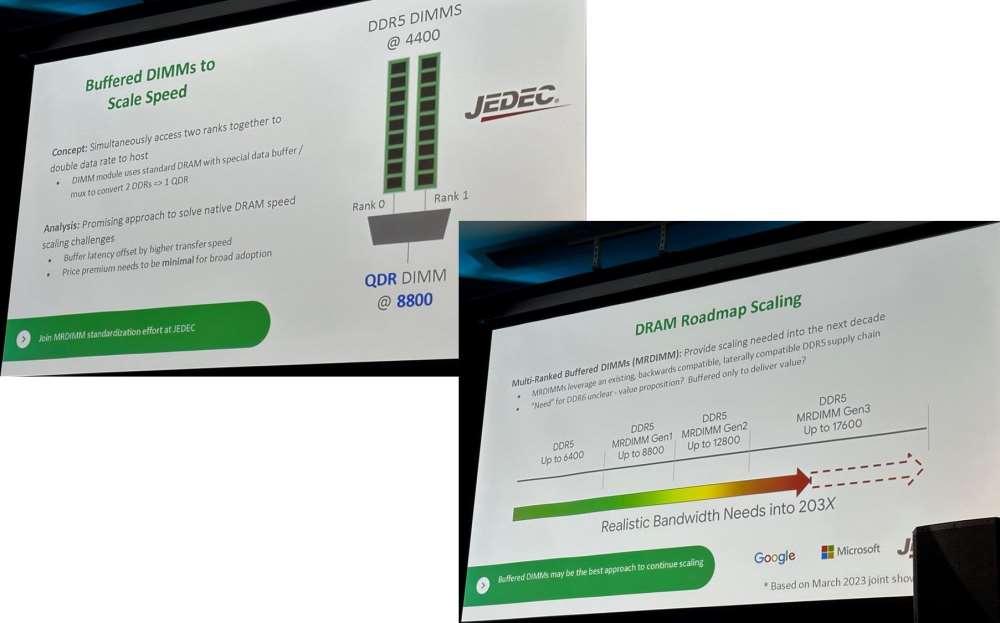
The JEDEC, the consortium of manufacturers of both volatile and non-volatile memories, that is, RAM and Flash, has just presented a new type of memory module that they have named as MRDIMM and that it brings with it a particularity that could change the configuration in future PC processors and motherboards. What particularities does it have and how will it influence future Intel and AMD CPUs?
PC RAM is typically more focused on latency than bandwidth. This is due to the common nature of central processing units, or CPUs, which makes their performance vulnerable to latency, since they have no way to mask it. Instead, a GPU or graphics chip does. The problem comes when we talk about applications that do depend on bandwidth and are limited in that regard. We’re talking about integrated graphics, RAM currently a bottleneck preventing further scaling, and Deep Learning and Machine Learning applications that are becoming more and more popular.
What’s so special about MRDIMMs?
It is very simple, the fact that it allows to combine the bandwidth of two memory modules. Currently we have two types of RAM memory modules for our PC: DIMM or SO-DIMM for our PCs. However, MRDIMM would not be a new standard, rather it would seek to solve the bandwidth problem.
How would it work? Suppose we have two DDR5-4800 modules, which means a bandwidth of 4.8 Gbps on a 128-bit bus with the CPU. The problem comes from the fact that each module contains a 64-bit data bus, but if we have four slots occupied, only 50% of all possible bandwidth is used due to the fact that there are not enough pins for data from the CPU.
Well then, at this year’s Memcom, JEDEC has presented its proposal for a new standard module that they have named MRDIMM. The concept is simple: place something as basic as a multiplexer between two DDR memory modules so that they combine their bandwidths and become a QDR module. That is, a 128-bit bus at 4.8 Gbps would become a 64-bit bus at 9.6 Gbps. The bandwidth remains the same, but we get another 64 data pins back and it allows us to double the bandwidth.
In the example they show memory at 8.8 Gbps per second that is obtained by combining the bandwidths of two DDR5 at 4.4 Gbps. His plans? Being able to reach 17.6 Gbps in a few years. That is, double that of current memories and all without having to launch a new generation of memory in the form of DDR6 in the middle.
It will mean changes inside the CPUs
In any case, this also means changes to the processor’s integrated memory controller, regardless of whether we are talking about Intel or AMD. In any case, we are more than sure that these changes are known by both manufacturers, who already have their future chips and motherboards prepared for these new memory modules. The bad of this solution? A reduction in the number of channels available and, therefore, a higher contention, as well as a higher latency to memory access.
In any case, it will be an important help to alleviate the current problem of integrated GPUs. Which seems to have stayed in no man’s land. The reason for this is simple: the lack of bandwidth from RAM means that they cannot scale in performance. Those who assume that adding more cores to them or increasing their clock speed even when paired with DDR5 memory is for naught due to the fact that those improvements are held back by the lack of transfer speeds.
While MRDIMM memory does not solve the contention problem, it does provide enough bandwidth for future integrated GPU models to scale beyond current capabilities. Who knows if this will help the APUs, or not, to engulf the lower range of graphics cards. Which already has signs of being abandoned by NVIDIA and AMD due to the increase in chip manufacturing costs and the few margins they give.





